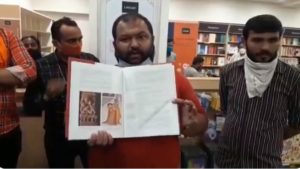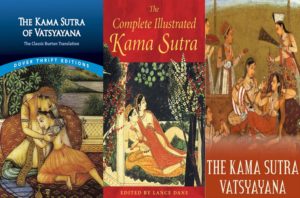India & World UpdatesHappeningsBreaking News
Bajrang Dal burns copy of Vatsayana’s Kamasutra, says book insults Hindu deities

Aug. 30: Shouting slogans of ‘Har Har Mahadev’ and ‘Jai Shree Ram’ members of the Bajrang Dal on Saturday allegedly burned a copy of the Kamasutra outsidea bookstore in Ahmedabad city of Gujarat. According to reports, the Bajrang Dal members said the Kamasutra shows Hindu deities in “vulgar position”. At least two videos of the burning of the Kamasutra also surfaced on Twitter. One of the videos was shot inside the bookstore. In that video, a member of the Bajrang Dal is seen showing the illustrations in the book, alleging that the same showed Hindu deities in “vulgar positions”.
 The Bajrang Dal members then came out of the bookstore and set the copy of Kamasutra on fire. The group chanted “Jai Shri Ram” and “Har Har Mahadev” while burning the book. Reports also said the group threatened the owner that they will burn down the bookstore if the sale of the book continues. It remained unclear outside which bookstore the Kamasutra was burned. It was also not clear whether the bookstore owner lodged any complaint.
The Bajrang Dal members then came out of the bookstore and set the copy of Kamasutra on fire. The group chanted “Jai Shri Ram” and “Har Har Mahadev” while burning the book. Reports also said the group threatened the owner that they will burn down the bookstore if the sale of the book continues. It remained unclear outside which bookstore the Kamasutra was burned. It was also not clear whether the bookstore owner lodged any complaint.
Vatsayana’s Kaamsutra has been a pride of India for centuries as has been the sculptures of Ajanta Ellora Khajuraho and Konark. So what do we expect? Bamiyan Buddha style demolition of all Indian heritage? 2/N pic.twitter.com/HX4vwHWlOV
— DP (@dpbhattaET) August 28, 2021
The Kamasutra is an ancient Indian Hindu Sanskrit text on sexuality, eroticism and emotional fulfillment in life. Attributed to philosopher Vātsyāyana, the Kama Sutra is neither exclusively nor predominantly a sex manual on sex positions, but written as a guide to the art of living well, the nature of love, finding a life partner, maintaining one’s love life, and other aspects pertaining to pleasure-oriented faculties of human life. It is a sutra-genre text with terse aphoristic verses that have survived into the modern era with different bhāṣyas (exposition and commentaries). The original composition date or century for the Kamasutra is unknown. Historians have variously placed it between 400 BCE and 300 CE. According to John Keay, the Kama Sutra is a compendium that was collected into its present form in the 2nd century CE.
 Vatsyayana’s Kama Sutra states it has 1250 verses, distributed over 36 chapters in 64 sections, organised into 7 books. This statement is included in the opening chapter of the text, a common practice in ancient Hindu texts likely included to prevent major and unauthorized expansions of a popular text. The text that has survived into the modern era has 67 sections, and this list is enumerated in Book 7 and in Yashodhara’s Sanskrit commentary (bhasya) on the text.
Vatsyayana’s Kama Sutra states it has 1250 verses, distributed over 36 chapters in 64 sections, organised into 7 books. This statement is included in the opening chapter of the text, a common practice in ancient Hindu texts likely included to prevent major and unauthorized expansions of a popular text. The text that has survived into the modern era has 67 sections, and this list is enumerated in Book 7 and in Yashodhara’s Sanskrit commentary (bhasya) on the text.




